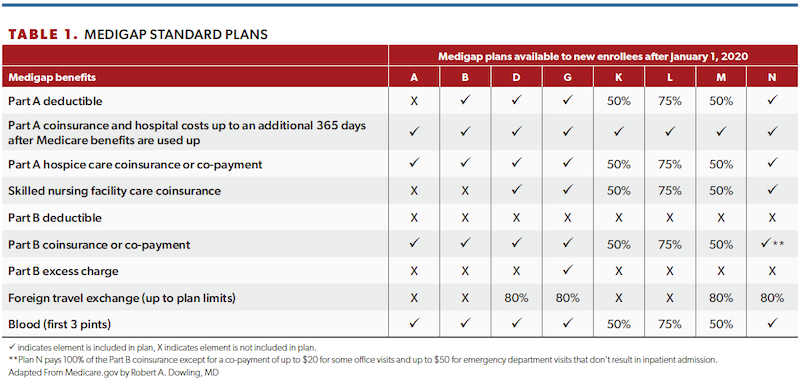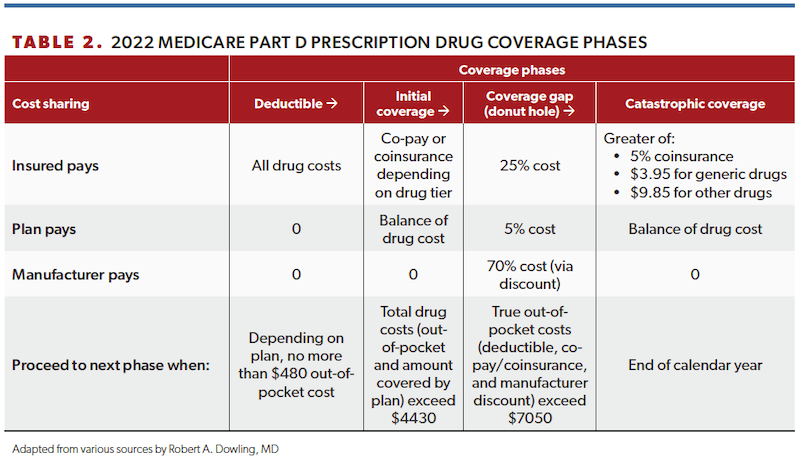Publication
Article
Urology Times Journal
How to understand Medicare from the patient perspective
Author(s):
Here is what patients experience enrolling in and participating in Medicare.
Robert A. Dowling, MD

It’s “Medicare season,” the time of year when Medicare Advantage ads begin to saturate the airwaves and patients may ask their doctors for advice. Most practicing urologists participate in traditional Medicare and/or Medicare Advantage plans and have a working knowledge of coverage rules, reimbursement issues, the Merit-based Incentive Payment System, and other regulations that affect Medicare providers. Many urologists, though, may not understand the basics or the nuances of enrolling in Medicare, choosing an Advantage plan, the costs in the program, premiums and penalties, and other important aspects of the care experience as a patient in Medicare. Indeed, many Americans don’t understand these issues and there is an entire industry of “Medicare advisers” (usually insurance brokers working on sales commission) who help educate patients, inform their decisions, and navigate their enrollment. In this article, I will offer a primer on these subjects to better prepare you to understand what Medicare patients experience.
When does Medicare “kick in”? Most Americans become eligible for Medicare coverage when they turn 65, but they must apply for that coverage; it does not happen automatically. The process involves 2 main steps: (1) signing up for Part A (hospital insurance) and Part B (medical insurance) during a specified enrollment period; and (2) choosing either Original Medicare or Medicare Advantage (Part C) as the method of coverage. The enrollment period for the first step starts 3 months before the 65th birthday and lasts 7 months. There are significant and ongoing penalties (in the form of increased premiums) for patients who fail to sign up during the initial enrollment period.
The second step involves a decision that can shape very different experiences for patients: Medicare Advantage vs Original Medicare. Enrollment in Medicare Advantage as a percentage of all eligible beneficiaries continues to grow each year and now stands at 45% nationally; in 11 states, Medicare Advantage penetration is above 50% of the market.1 Medicare Advantage enrollees tend to be older and have lower incomes and more chronic conditions than Original Medicare enrollees.2 Original Medicare offers patients the flexibility to see any participating Medicare provider in the United States without a referral. Medicare Advantage HMO and PPO plans have a provider network and may require referrals to see a specialist; in return, they usually offer additional services (vision, hearing, and dental), no Part B copayments, and a bundled drug plan. Original Medicare offers the flexibility to choose a supplemental insurance plan and a drug plan (Part D) from a wide range of options.
How much do patients pay for Medicare? Costs in each part of Medicare can be broken down into premiums, deductibles, and co-payments. Most Medicare beneficiaries receive Part A insurance “premium free” in return for contributing Medicare taxes during their or their spouse’s working years. The deductible for Part A in 2022 is $1556 for each hospital stay per benefit period and co-payments for inpatient stays are $0 for the first 60 days. Premiums for Part B are more complicated and are tied to adjusted gross income (AGI) of the beneficiary 2 years earlier. In 2022, everyone with AGI less than $91,000 (individual) or $182,000 (joint filers) in 2020 will pay $170.10/month for Part B; higher earners must pay an income-related monthly adjustment amount (IRMAA) that can be up to an additional $408.20/month. As mentioned earlier, there is a late enrollment penalty for people who do not sign up for Part B when they are first eligible—10% added to the premium for each year they were eligible but did not enroll. The annual deductible for Part B is $233 and the co-insurance is 20% of the allowed charges (original Medicare). Seniors pay the same premium for Part A (usually zero) and Part B whether they are in Original Medicare or Medicare Advantage; Advantage plans may subsidize part of the Part B premium, may have their own premium, and may have their own co-insurance for services.
Is a supplemental plan required? No, but most people (around 85%) with Original Medicare have a supplemental insurance policy that they buy themselves during initial enrollment (Medigap) or are provided through employer insurance. Medigap insurers are licensed by states but the policies (benefits) offered are standard across the country; Medigap policies are no longer allowed to cover the Part B deductible, and all cover Part A co-insurance and some or all of the Part B co-insurance.3 Some plans cover emergency services in other countries. (Original Medicare does not.) (See Table 1.) The only differences between a given plan offered by 1 insurer vs another are the premium and, perhaps, the customer service (website, bill payments, etc).

What about preexisting conditions? People newly eligible for Medicare cannot be denied Part A, Part B, or Medigap insurance (if they apply during the initial enrollment period) because of preexisting conditions, and Medigap renewal is guaranteed (premiums can go up). In all but 4 states, though, an insurance company can deny Medigap coverage except during the initial enrollment period. One common scenario is that a senior may have enrolled in Original Medicare with a Medigap policy, but later switched to Medicare Advantage. If they wish to return to original Medicare with a supplement, they may have to undergo underwriting for a Medigap policy and can be denied (except under special circumstances). Similarly, it is not easy to switch between Medigap plans. In practice, seniors can be “locked into” their Medigap selection for as long as they remain in Original Medicare. It’s an important decision.

The final piece of the puzzle is the most complicated: plans that cover prescription drugs. Seniors in Medicare Advantage plans typically have their drug plan bundled as part of that plan, and those in Original Medicare purchase a Part D drug plan from an insurer licensed in the state. Like Part B, there is a permanent premium surcharge if a senior doesn’t enroll in Part D when first eligible; like Part B, the monthly premium for Part D is adjusted for income (IRMAA). Unlike Medigap policies, Part D drug plans may be easily switched annually. Part D plans have a deductible (less than $480) and a standard but complex framework for co-insurance after the deductible is met. (See Table 2.) For all plans, there is an initial coverage period with co-insurance determined by the plan and the drug tier; once a drug cost threshold is exceeded (in 2022, this is $4430) there is a coverage gap or “donut hole” during which the beneficiary usually pays 25% of drug cost until true out-of-pocket costs exceed $7050; finally, there is a catastrophic period where the co-insurance is usually 5%. Medicare’s website can guide seniors through plan options available in their area based upon their current medications and prescriptions and estimate total out-of-pocket costs.4
Here is a fictitious example that can illustrate what a senior might face with Medicare coverage. A 65-year-old attorney with a 2020 AGI of $500,000 has just retired, enrolled in original Medicare, and purchased a Medigap Plan G policy and Part D drug plan. He takes Eliquis 2.5 mg bid and tamsulosin 0.4 mg q day. Assuming no hospitalizations, outpatient procedures, or doctor visits, his costs in the first year are as follows:
Part A premium: $0
Part B premium (including IRMAA): $544 monthly
Medigap Plan G premium: $135 monthly
Part D premium (including IRMAA): $101 monthly
Drug cost (average): $90 monthly (projected annual out-of-pocket expense through all phases/12)
Total: $870 monthly
If the same patient had a hip replacement as an inpatient, his costs would be as follows:
Part A deductible: $0 (covered by Medigap Plan G)
Part B deductible: $233
Copays for doctor visits: $0 (Covered by Medigap Plan G)
Co-insurance for surgeon fee: $0 (Covered by Medigap Plan G)
The bottom line and why it matters
Medicare is an entitlement program enjoyed by millions of Americans but it is neither automatic nor free; many recent retirees may find they pay more out of pocket for Medicare in their first years than they did for private insurance. Medicare patients make up a significant fraction of the typical urology practice, and those in Original Medicare enjoy coverage for medically necessary services without a need for referral or, usually, prior authorization for tests and procedures. Urologists will benefit from a working knowledge of the program, the benefits, and the costs as seen through the eyes of the patient. Go to medicare.gov for more perspective on the patient side of Medicare.
References
1. Medicare Advantage enrollment continues to surge in an increasingly complex and competitive landscape: 2022 Medicare Advantage competitive enrollment report. The Chartis Group. February 25, 2022. Accessed August 26, 2022. https://bit.ly/3pTWuK4
2. Tarazi W, Welch WP, Nguyen N, et al. Medicare beneficiary enrollment trends and demographic characteristics. Assistant Secretary for Planning and Evaluation Office of Health Policy Issue Brief. March 2, 2022. Accessed August 26, 2022. https://bit.ly/3CEoVmE
3. What’s Medicare Supplement Insurance (Medigap)? Medicare.gov. Accessed August 26, 2022. https://bit.ly/3R0rfc1
4. Explore your Medicare coverage options. Medicare.gov. Accessed August 26, 2022. https://bit.ly/3Kt6e7m































